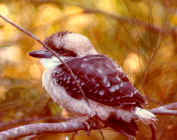Background
information
Australian animals, tree hollows and nestboxes
Australian topics
Nankeen kestrel
Eastern pygmy possum
Green tree frog
Microbats general
Batboxes in
Organ Pipes National Park
Gould's wattled bat
Chocolate wattled bat
Large-footed myotis
Bats, Mosquitoes and Dollars
| Australian animals, tree hollows and nestboxes |
|
|
| Home / Contact us / Product range / Stories / Pest management / Prices |
| One of the least
known characteristics of Australian animals is their high utilisation of tree hollows. For
example, the proportion of Australian animals that use tree hollows is three times greater
than in North America and twice as great as in South Africa. About 350 Australian animals use hollows for either
roosting or nesting. This includes: |
|
|
|
Nearly 20% of our birds use hollows in some way. For 60% of these, hollows are essential for survival. Unlike elsewhere in the world, Australia has no woodpeckers to carve out hollows; ours are formed by slow decay, usually within eucalypts. Gums start to grow hollows at about 130 years, with a typical lifespan of about 400 years. The reality is that most of our old gums pre-date European settlement, and are effectively a non-renewable resource. Can anyone imagine a tree that they plant - anywhere, being likely to survive for 130 years? Another problem which gets little recognition is the effect of introduced animals. There are many natural hollows which are currently occupied by the introduced honeybee, and many more filled with honeycomb after bees have left. Starlings and Indian mynas are very aggressive competitors for the few hollows that are left. So as the availability of natural hollows declines, where will our animals live and breed? Providing artificial hollows is far from an ideal solution and should never be used as justification for felling old trees. However, where natural hollows have already been severely depleted, nestboxes are one of the few choices we have. Even where there does not appear to be a problem, the dependence of Australian animals on tree hollows is so strong that we need to develop alternatives now as an insurance for the future. |
|

